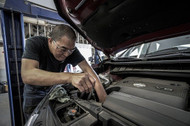Don't Wait to Replace a Cracked Radiator Hose
4th Jun 2020

Replace a Cracked Radiator Hose
Consisting of flexible rubber with a hollow interior, radiator hoses are used to transport coolant between your vehicle's radiator and its engine. Most vehicles have two radiator hoses. You'll discover a top hose as well as a bottom hose, both of which circulate coolant. Because they are made of rubber, though, radiator hoses have a tendency to dry out over time. Eventually, a radiator hose may become so dry that it cracks. If you have one or more cracked radiator hoses, you shouldn't ignore this problem.
Loss of Coolant
Your vehicle may lose coolant if it has a cracked radiator hose. Coolant becomes pressurized as it warms up. If there's a crack in a radiator hose, the pressurized coolant will attempt to escape through the crack. You may notice any loss of coolant when your vehicle's engine is cold. Rather, the leak may only manifest after the engine has warmed up. Regardless, a cracked radiator hose can lead to a loss of coolant.
Engine Overheating
If your vehicle loses enough coolant, its engine may overheat. Vehicles require a certain amount of coolant to remove heat from the engine. As coolant leaks out through the cracked hose, your vehicle's engine may overheat. The temperatures will slowly climb, at which point catastrophic damage may occur. Overheating can cause head gaskets to blow or engine blocks to crack, both of which are expensive to fix.
Radiator Damage
A cracked radiator hose can also damage your vehicle's radiator. If your vehicle has a plastic radiator, the hot air trapped inside may cause it to crack as well. Alternatively, the radiator neck may warp from the hot temperatures, at which point the cap may no longer create a sealed fit.
Replacing a Cracked Radiator Hose: What You Should Know
Rather than trying to patch a cracked radiator hose, it's recommended that you replace it. The problem with patching a cracked radiator is that it may not hold once your vehicle's engine has warmed up. A warm engine will pressurize the coolant, meaning it will push against the hose's interior walls. If you simply patched the cracked radiator hose, it may break in response to the pressurized coolant.
Replacing a cracked radiator hose, on the other hand, will prevent it from leaking. Just remember to choose a replacement hose in the same size as the cracked hose. And when installing it, tighten the clamps so that it can withstand the pressurized coolant.

